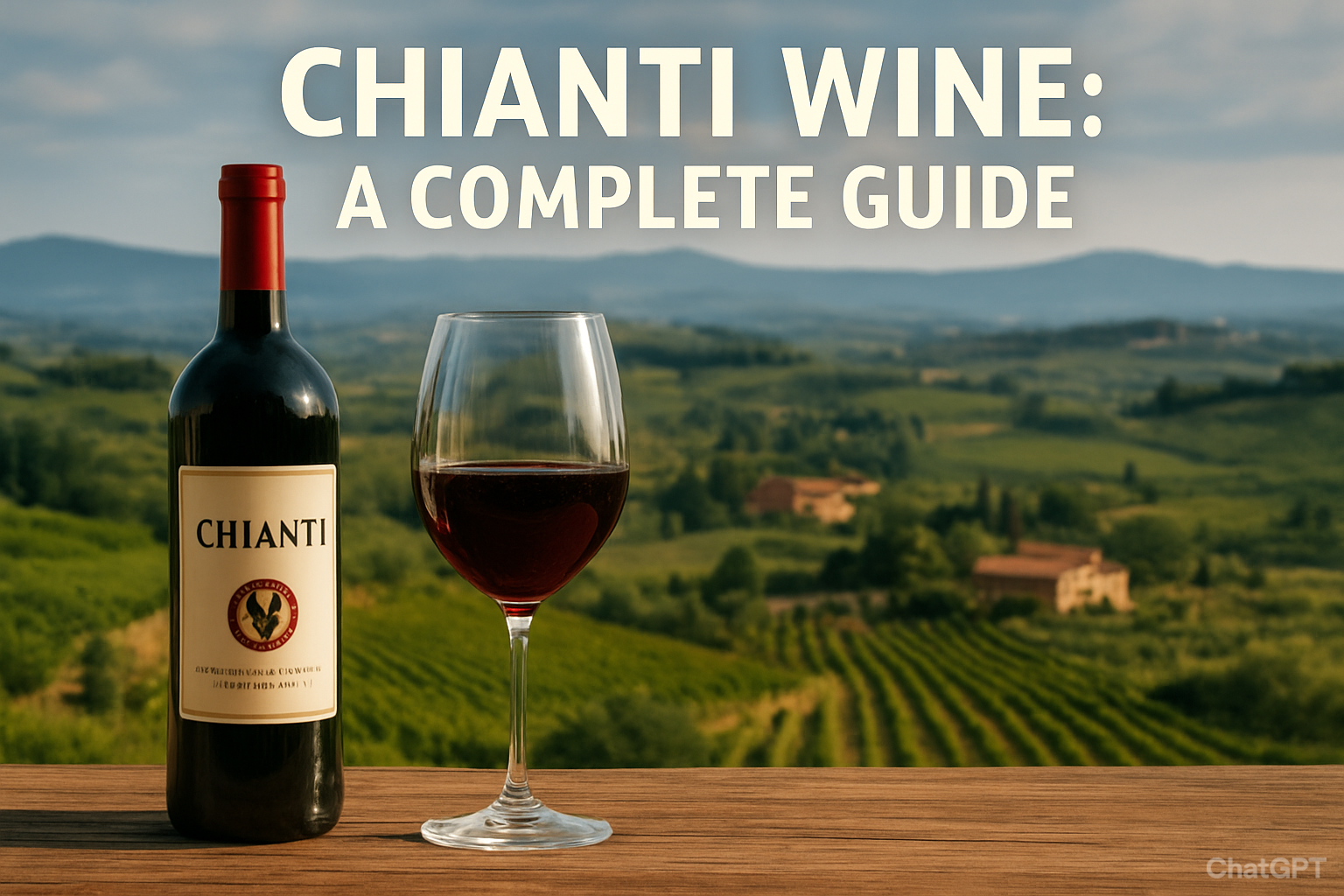Chianti wine is one of the most famous Italian wines. It is made mainly from Sangiovese grapes, a variety grown in the Chianti region of Tuscany. Known for its ruby-red color, medium body, and fresh acidity, this wine has become a symbol of Italian culture and tradition.
The flavor of Chianti wine is usually bright, with notes of cherry, red plum, and herbs. Some types also show earthy and spicy tones. Because of its balanced structure, Chianti is considered very food-friendly.
The History of Chianti Wine
The roots of Chianti wine date back to the 13th century. Records show that the region between Florence and Siena was already producing red wine during this time. By the 18th century, Chianti had gained recognition beyond Italy, becoming one of the first officially defined wine regions in the world.
In 1716, the Grand Duke of Tuscany, Cosimo III, created laws to protect the boundaries of the Chianti region. This action ensured that the wine’s identity would remain tied to its land. Over time, strict rules were added to improve the quality and reputation of Chianti.
The Chianti Region and Its Zones
The Chianti region is located in central Tuscany. Rolling hills, vineyards, and olive groves dominate the landscape. The climate is warm with cool nights, which helps grapes ripen slowly and develop rich flavors.
Chianti wine is not made in just one place but in several zones:
Chianti Classico: The most traditional and well-known area. Bottles from here often carry a black rooster symbol on the label.
Chianti Rufina: A smaller zone with higher altitudes, leading to more elegant wines.
Chianti Colli Senesi, Colli Fiorentini, and others: Each sub-zone has unique characteristics based on soil and climate.
Types of Chianti Wine
Chianti wine comes in several styles, depending on aging and production methods:
Chianti: The basic version, usually light and meant for early drinking.
Chianti Classico: Higher quality, aged longer, and often richer in taste.
Riserva: Aged at least two years in oak and three months in bottle. These wines have more depth and complexity.
Gran Selezione: The top tier, made only from the best grapes of a winery’s own vineyards.
Flavor Profile of Chianti Wine
The taste of Chianti wine is often described as lively and refreshing. It usually has red fruit flavors like cherry and strawberry. Herbs such as oregano and thyme often appear in the aroma.
Older Chianti wines, especially Riserva and Gran Selezione, develop deeper flavors like leather, tobacco, and dried flowers. Tannins give the wine structure, while bright acidity keeps it fresh.
Food Pairings with Chianti Wine
Chianti wine is famously paired with Italian food. Because of its acidity, it cuts through the richness of cheese, meats, and pasta sauces.
Some classic pairings include:
Pasta with tomato-based sauces
Pizza with fresh mozzarella
Roasted chicken or pork
Grilled steak, especially the Tuscan bistecca alla Fiorentina
Aged cheeses such as Pecorino Toscano
Beyond Italian cuisine, Chianti also works well with burgers, barbecue, and even certain spicy dishes.
How Chianti Wine Is Made
The production of Chianti wine follows strict guidelines. At least 70% of the blend must be Sangiovese grapes. The rest can include other native Italian grapes such as Canaiolo and Colorino, or international varieties like Merlot and Cabernet Sauvignon.
After harvesting, grapes are crushed and fermented. The wine is then aged in barrels, cement tanks, or stainless steel, depending on the style. Oak aging adds spice and vanilla flavors, while steel keeps the wine bright and fruity.
Chianti Wine and Its Symbol: The Black Rooster
The black rooster, or Gallo Nero, is the official symbol of Chianti Classico. Legend says it comes from a story between Florence and Siena, two rival cities. To settle a land dispute, they decided to send riders at dawn. The border would be set where the riders met.
Florence chose a black rooster, which was kept hungry so it would crow early. The rooster crowed before dawn, giving the Florentine rider a head start. As a result, Florence gained more land. Today, the rooster stands as a proud emblem of Chianti Classico.
The Difference Between Chianti and Other Wines
Many people confuse Chianti wine with general Italian red wines. However, Chianti has strict regional rules, making it unique. Unlike simple table wines, Chianti carries a strong identity linked to Tuscany.
Compared to Barolo or Brunello, Chianti is usually lighter and more approachable. While it can age beautifully, most Chianti bottles are meant to be enjoyed within a few years of release.
How to Serve Chianti Wine
Serving Chianti wine properly helps bring out its flavors. Here are some tips:
Temperature: Serve between 60–65°F (15–18°C).
Glass: Use a medium-sized red wine glass.
Breathing: Younger Chianti benefits from 30 minutes of decanting. Riserva and Gran Selezione may need more time.
Buying Chianti Wine
When buying Chianti wine, look at the label carefully. Check the zone (such as Classico), the quality level (Riserva or Gran Selezione), and the vintage year.
Prices can range widely. A simple bottle may cost under $15, while top Chianti Classico Gran Selezione bottles may cost over $100. However, most good Chianti wines are affordable compared to other famous wines.
Chianti Wine in Modern Culture
Chianti wine is not only popular in Italy but also around the world. It has appeared in movies, books, and songs, becoming part of popular culture. One famous mention comes from the film The Silence of the Lambs, where Chianti is named in a chilling line.
Despite that dark association, Chianti remains loved for its bright, food-friendly nature. Today, it is exported globally, bringing a taste of Tuscany to millions of wine lovers.
Health Benefits of Chianti Wine
In moderation, Chianti wine may provide health benefits. Sangiovese grapes contain antioxidants like resveratrol, which support heart health. Moderate red wine consumption has been linked to reduced risk of certain cardiovascular issues.
Still, wine should be enjoyed responsibly. Too much alcohol can harm health, so balance is key.
The Future of Chianti Wine
The future of Chianti wine looks bright. Winemakers continue to improve techniques, focusing on sustainability and organic farming. Climate change presents challenges, but innovation is helping the region adapt.
Chianti is expected to remain a favorite for both everyday meals and special occasions. Its timeless balance of flavor, history, and culture ensures its lasting place in the world of wine.
Conclusion
Chianti wine represents more than just a drink. It carries centuries of tradition, a sense of place, and the spirit of Tuscany. From simple bottles enjoyed with pizza to prestigious Gran Selezione wines opened at celebrations, Chianti continues to connect people to Italian culture.
For anyone exploring wine, Chianti is a perfect place to start. It offers variety, history, and flavor—all in a glass of ruby-red brilliance.

